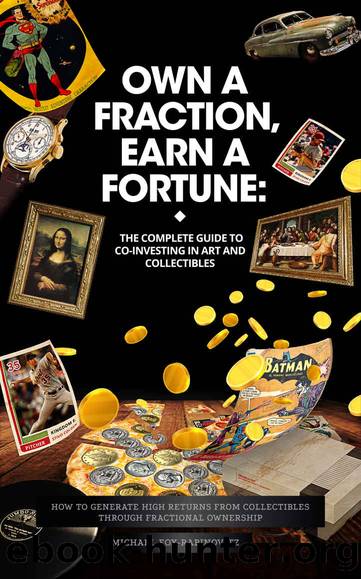Own a Fraction, Earn a Fortune: The Complete Guide to Co-investing in Art and Collectibles: How to Generate High Returns from Collectibles Through Fractional ... the Investments of by Michael Fox-Rabinovitz

Author:Michael Fox-Rabinovitz [Fox-Rabinovitz, Michael]
Language: eng
Format: epub
Published: 2020-12-08T23:00:00+00:00
Manuscripts
Before the inventions of printing, in China by woodblock, and in Europe by movable type in a printing press, all written documents had to be both produced and reproduced by hand. Historically, manuscripts were produced in form of scrolls or books written on vellum and other parchment, papyrus, or other materials. In Russia, birch bark documents from the 11th century have survived, and in India, the palm leaf with a distinctive long rectangular shape, was used from ancient times until the 19th century. However rare a printed book is, itâs still one of several copies available. But if you buy manuscripts, every item is completely unique. Manuscripts have been regularly sold since about the 12th century, and since then theyâve been a solid and steady market presence.
Most surviving pre-modern manuscripts use the codex format (as in a modern book), which had replaced the scroll by Late Antiquity. Some of the most common genres were bibles, books of hours, liturgical texts, religious commentaries, philosophy and law and government texts, with the book of hours the one best known today. A book of hours was used for owners to recite prayers privately eight different times, or hours, of the day. Each book of hours contains a similar collection of texts, prayers, and psalms, and books of hours made for wealthier patrons can be extremely extravagant with full-page miniatures, which is what makes them so valuable.
Though there are fluctuations, values have recently been increasing. There has been in the past five to ten years a significant uptick in interest in manuscripts, not just illuminated medieval manuscripts, books of hours, major literary manuscripts or archives, but also far less canonical items of âsocial historyâ, from manuscript commonplace and recipe books to diaries and scrapbooks, and even notes scrawled in the margin of printed works. The overriding-factor here is a âuniquenessâ that outpaces the impact of-digitization on the rest of the market.
Historical returns: To be conservative, we can estimate the returns on rare manuscripts to be similar to those of books at around 7% annualized, as there is no clear index to measure the true returns for the space. However, it is advisable to keep an upward bias with regard to these due to an even higher degree of rarity.
Download
This site does not store any files on its server. We only index and link to content provided by other sites. Please contact the content providers to delete copyright contents if any and email us, we'll remove relevant links or contents immediately.
| Sports Cards | Sports Memorabilia |
How to Be a Bawse: A Guide to Conquering Life by Lilly Singh(6706)
Spare by Prince Harry The Duke of Sussex(4228)
Millionaire: The Philanderer, Gambler, and Duelist Who Invented Modern Finance by Janet Gleeson(3577)
Harry Potter 02 & The Chamber Of Secrets (Illustrated) by J.K. Rowling(3298)
Urban Outlaw by Magnus Walker(2953)
The Heroin Diaries by Nikki Sixx(2943)
Never by Ken Follett(2915)
Japanese Design by Patricia J. Graham(2564)
The Club by A.L. Brooks(2382)
Machine Learning at Scale with H2O by Gregory Keys | David Whiting(2325)
The Man Who Died Twice by Richard Osman(2313)
Stacked Decks by The Rotenberg Collection(2285)
Harry Potter and the Deathly Hallows (7) by J.K. Rowling(2238)
Fairy Tale by Stephen King(2101)
Will by Will Smith(2077)
Harry Potter and the Prisoner of Azkaban (Book 3) by J. K. Rowling(2073)
Churchill by Paul Johnson(2019)
The Chimp Paradox by Peters Dr Steve(1872)
The 7 Habits of Highly Effective People: Powerful Lessons in Personal Change (25th Anniversary Edition) by Covey Stephen R(1843)
